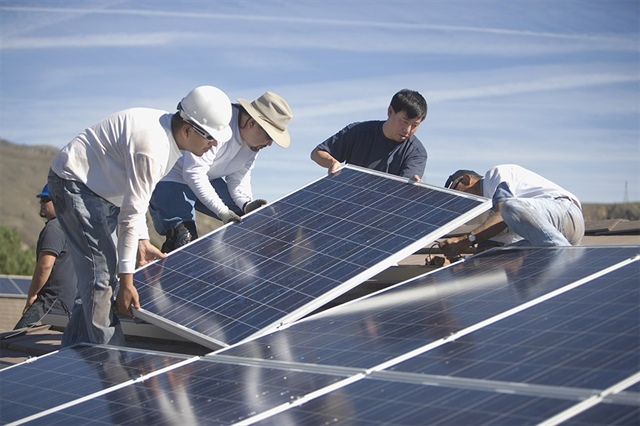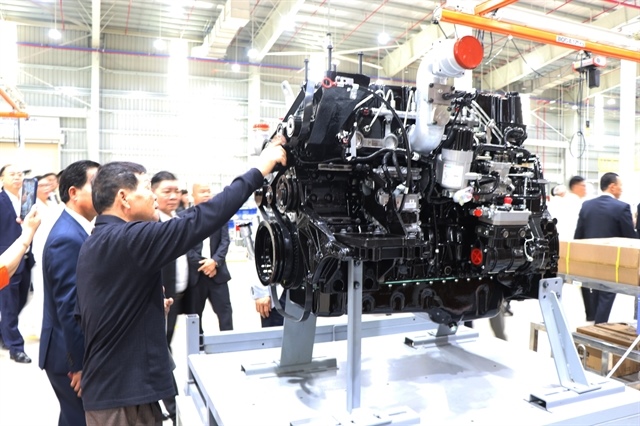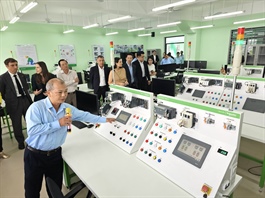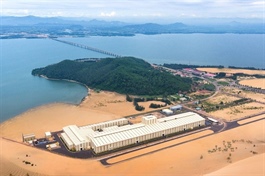Power plan update to incorporate solar
Power plan update to incorporate solar
To meet the electricity demand for economic development, the Ministry of Industry and Trade has proposed to increase solar power capacity in the country’s official power development plan.
Minister of Industry and Trade Nguyen Hong Dien last week said at the consultation meeting to adjust the Power Development Plan VIII (PDP8) that by 2030, Vietnam must triple current electricity capacity, moving towards a scale 5-7 times larger by 2050.
“To achieve these goals, energy growth must be synchronised with economic scale, while meeting the international commitment to carbon neutrality by 2050. This requires a rapid adjustment of the PDP8, to accommodate strong growth demand and the trend of clean energy transition,” he said.
In the draft adjusted PDP8, the Ministry of Industry and Trade (MoIT) proposed five scenarios for installed power capacity and calculated the total installed power capacity nationwide by 2030 to reach 211,800MW, an increase of 56,200MW compared to the PDP8 approved nearly two years ago.

Solar-based ventures can be made operational in much quicker time than other energy project types |
To achieve the increased capacity, the MoIT proposed to expand the room for developing renewable energy sources, imported electricity, and flexible thermal power sources.
Accordingly, solar power capacity is proposed to increase dramatically to 34,000MW, an increase of more than 25,000MW compared to the previous plan. The additional capacity of solar power alone accounts for about 45 per cent of the total additional power capacity of the entire system by 2030.
This helps raise the solar power ratio from only 5.7 per cent of the power structure to 16 per cent when adjusting the planning.
Along with that, pumped storage hydropower and battery storage are also proposed to increase six-fold from 2,700MW to 15,250MW; hydropower to climb by about 5,000MW; and onshore and nearshore wind power by more than 7,000MW. Meanwhile, imported power from China and Laos could triple to 14,600MW.
The MoIT removed 6,000MW of offshore wind power from the planning due to concerns about planning issues and implementation progress.
Between 2031 and 2050, after nuclear power is put into operation, renewable energy sources will continue to be strongly developed. In 2050, rooftop solar power will increase sharply to more than 137,000MW, 3.5 times higher than the previous calculation. Concentrated solar power will increase by 77,000MW, and pumped storage hydropower and battery storage will increase to 11,200MW, nearly 2.5 times higher.
Nguyen Huy Hoach from the Vietnam Energy Association said that the PDP8 implementation is behind schedule.
“With an adjusted plan, the expected power source will increase by 56,200MW, which is a huge challenge. If there is no breakthrough solution, it is easy to lead to a suspended plan,” Hoach said.
According to Hoach, the MoIT is strongly increasing solar power to compensate for other power sources in the coming period because the construction time of solar power projects is quick, at only 3-6 months in many cases.
“The key issue is that the current solar power price mechanism has been stuck for a long time and has not been resolved yet. In particular, in recent times, investors have also realised that there are many risks when policies are constantly changing. A series of solar power projects that violated regulations and were slow to handle, causing hundreds of thousands of US dollars to be wasted, have made investors uneasy,” he said.
He explained that the sharp increase in solar power will also lead to a boom in the construction of these projects many times more than in the recent period, causing the transmission system to fail to meet the demand, causing system overload. Rooftop solar power currently does not have a policy to develop a battery storage system, leading to difficulties in regulation of power, Hoach added.
|
Nguyen Anh Tuan, vice president and general secretary, Vietnam Energy Association Adjusting the electricity demand forecast is necessary and consistent with the reality and development direction of the Party and the state. With an expected GDP growth rate of 8 per cent in 2025 and 10 per cent in the period of 2026-2030, electricity demand will increase. Increasing solar power capacity from 18GW to 34GW and wind power from 19.5GW to 22GW is feasible. Regarding liquefied natural gas, although regulations were issued in 2024 on the mechanism for direct electricity purchase and sale between renewable energy power generators and large electricity users, many projects are still behind schedule due to the lack of complete power purchase and sale contracts. The government must soon issue regulations on gas price transfer to launch important projects such as the Nhon Trach power venture. On pricing, the fixed power purchase and sale contract model should be abandoned and a more flexible market mechanism be adopted. This is an important step forward to help Vietnam build a sustainable and modern energy system. Ngo Tan Kiet, former director Institute of Energy Science The socioeconomic situation is changing rapidly, requiring adjustments to the PDP8 to meet stronger development needs. In particular, the decision to restart two nuclear power projects is a major strategic step. Although the received draft adjustment is still abridged and lacks detailed calculations, the Drafting Committee has made efforts to carry out the task in a short time, basically meeting the requirements on development perspectives and goals. Currently, the north and the south are still the two main economic centres, while the centre of the country, despite possessing a lot of renewable energy potential, has not been properly exploited. It should to study a scenario for economic development in the central region to reduce the pressure on power transmission to other areas of the country. This not only helps to minimise the risk of natural disasters to the transmission system but also makes the most of available energy sources on the spot. Regarding coal sources, many large projects have not found investors and need to be temporarily suspended. However, Vietnam should consider encouraging the role of domestic state-owned economic groups instead of relying too much on foreign capital. In particular, investing in key projects such as the Quang Trach power plant is necessary to reduce capital pressure. Nuclear power will help ensure long-term energy supply. With experience from previous feasibility studies, Vietnam can shorten the implementation time, aiming to complete the first two nuclear power plants within 5-6 years if there is determination and appropriate mechanisms. |
- 15:07 21/02/2025



























